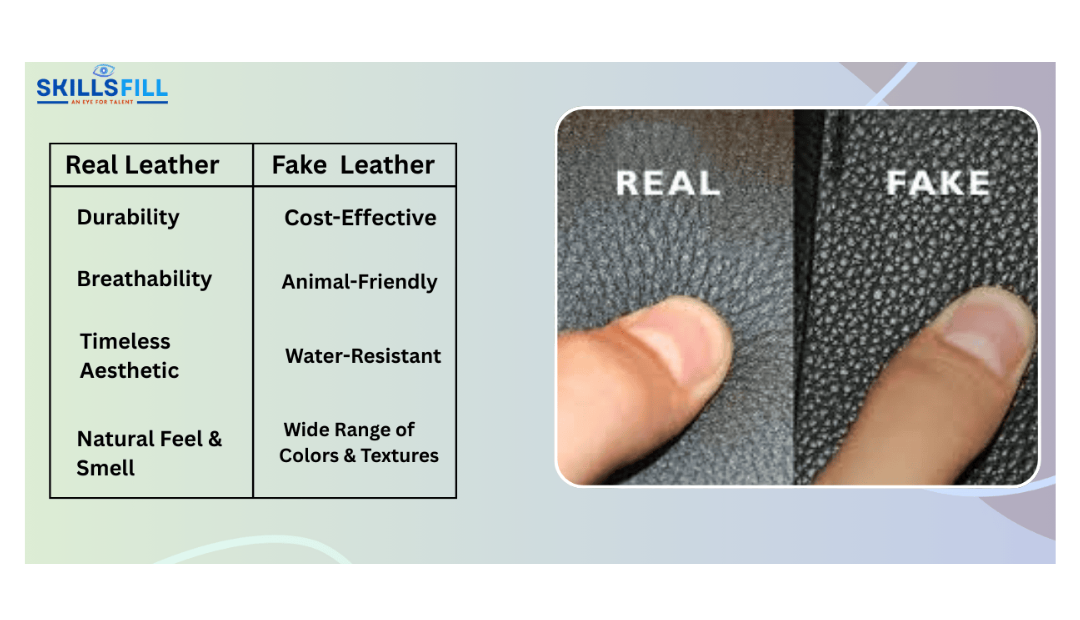When buying products such as jackets, shoes, bags, etc. made of leather, it is crucial to know precisely what you are purchasing. Real leather is stylish and long-lasting, but comes at a steep price-wise. Fake leather, on the other hand, is cheaper but does not have the same quality.
SkillsFills mission is to assist you in building skills that will enable you to make important choices with confidence. Let’s talk you through how to differentiate fake leather from real leather and the types of leather out there.
Types of Leather
Before learning how to distinguish between fake and real leather, it is significant to learn about the different types of leather that are available in the market.
1. Real Leather

The top layer or the “grain” of animal hides, typically cattle, is what “Real leather” refers to, more specifically full-grain and top-grain. It is known to be quite strong and sturdy with impressive natural texture and aging. Full grain leather features visible imperfections and wears well over time. It is mostly found in expensive products like best leather bags, premium belts, and furniture. When it comes to high-end products, we advise our clients at SkillsFill to always check the labels.
2. Genuine Leather

Genuine leather refers to a lower grade of real leather. The material is constructed out of various fragments which are left over after the top layers of the hide are removed. Genuine leather is not as rich or as durable as high quality leather, but it is treated and painted to mimic one. Like most other things, it can be found at a wallet-friendly price. This is why belts, wallets, and many low to mid range accessories are manufactured using ‘genuine leather’.
3. Faux leather

Unlike genuine leather, faux leather is made with fabrics which are harmful to the environment such as polyurethane or polyvinyl chloride. It seeks to replicate leather while proving to be more affordable and animal friendly. Faux leather isn’t as durable and will crack or peel over time, but it does find its way into vegan collections and budget-friendly products. SkillsFill believes that all consumers, whether looking for a long lasting product or a sustainable one, should have the right information to make that decision.
How to Identify Fake or Real Leather
Your understanding of leather types shrinks the gap between ‘how to tell fake leather from real’ by a great margin. The good news is that you don’t need in depth knowledge to get the real deal. With a few simple tips, you can outsmart the marketers and do smarter shopping.
1. Examine Closely The Surface Texture
The texture of real leather is uneven and has small natural defects such as wrinkles, pores, and lines. Each piece of it is different. Faux leather usually looks too shiny, smooth, or repeating pattern. Running your fingers on it, real leather will feel uneven while faux leather will be uniform.
SkillsFill Tip: Good quality natural leather will often have minor scars or irregular pores.
2. Test With The Nose
The easiest method to differentiate between real leather and faux is by the fragrance. The former has a characteristic earthy aroma that is rich, warm, and natural while the latter would smell like plastic because it is made out of synthetic materials.
3. Absorption Test
Moisture is absorbed by real leather. If you put a small amount of water on it, it will slowly seep into the surface while faux leather will leave the water sitting on top or repel it.
Note: Use with caution and make sure to ask before doing the test in a store.
4. Fire Safety Assessment
While this is not the best method for costly items, real leather takes time to ignite and emits an odor similar to burned hair. In contrast, fake leather ignites easily and releases fumes characteristic of burning plastic.
SkillsFill Safety Tip: This method is dangerous. Use other ways first unless you’re working with scraps.
5. Examine the Perimeter
Genuine leather will be rough along the edges as it is removed from animal hides. Faux leather, on the other hand, will have smooth and flawless edges because it is created by a machine.
Confirmation: Simply flip the item over, or check the seams and trims.
6. Press and Stretch the Surface
The authentic leather will display wrinkles and shifts in color when pressed or stretched. Faux leather remains stiff and does not bend in a natural way.
7. Labels and Price
Remember to always check product labels. „Full-grain leather“ or „Top-grain leather“ means the item is of high quality. However, most likely the item is plastic if the label displays „PU leather,” „Vegan leather,” or „Manmade material.”
Keep an Eye on the Price: Beware that most items crafted from real leather are significantly pricier. If the cost appears suspiciously low, it most likely is.
Why Knowing The Difference Is Important:
Understanding how to tell apart real or fake leather will improve your decision making. Investing in high-quality, genuine leather items is reasonable since they are durable and appreciate over time. If you are on a strict budget and are ethically concerned, then faux leather is more suited for you, but keep in mind that it does not last as long. Depending on the personal approach style, ethics, or financial considerations, one can make a decision.
Here at SkillsFill, we strive to provide you with practical skill sets to aid you in making confident purchases.
Other Questions: Knowing The Difference Between Fake Or Real Leather
Q1: Is genuine leather real or fake?
Genuine leather is real leather, but not the most refined. It is manufactured from lower parts of the hide, which does not last as long as full-grain leather. Though it is better than faux leather, it still lacks the luxury feel.
Q2: How do I check if my leather bag is real?
You may consider evaluating the texture, color, smell, and edges. Real leather bags should have distinct grooves, an irregular surface, and an earthy scent along with good stitching. If you are unsure, you can perform the water test or examine the label.
Q3: What does PU leather mean?
PU leather, also known as synthetic leather, is a type of faux leather crafted out of polyurethane. It is less costly and less durable than genuine leather which causes it to be labelled “vegan leather.”
Q4: Does real leather crack?
In due course, real leather undergoes a certain softness-known as patina and may incur soft wrinkles but will not peel nor crack like fake leather does. When maintained properly ,real leather gains in beauty over time.
Q5: Can I use real leather in rainy weather?
While real leather can absorb, and may sustain damage if soaked in it, leather waterproofing spray or conditioner adds a protective barrier. Leather mimics are better suited for wet conditions but are less durable in the end.
Q6: Is faux leather a bad choice?
Not always. Faux leather is perfect for those wanting to spend less or support ethical sentiments. It is fashionable and adaptable but will wear out faster than real leather.







